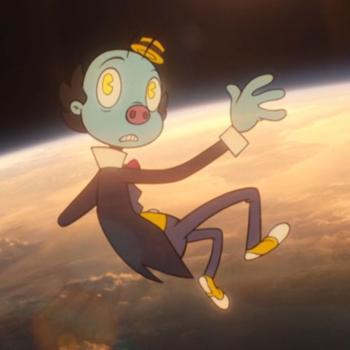 The Doctor Who episode “Snakedance” from the Peter Davison era is the sequel to the earlier episode Kinda, featuring the same enemy, the Mara, an evil presence which can hide within a mind and take control of it, and from there (if it can find the power to do so) emerge into physical form as a snake. In this episode, we learn the origin of the Mara, and the episode provides some interesting points for reflection about the nature of good and evil and other big questions. If you’ve never seen it and plan to, then be warned that there will be spoilers below.
The Doctor Who episode “Snakedance” from the Peter Davison era is the sequel to the earlier episode Kinda, featuring the same enemy, the Mara, an evil presence which can hide within a mind and take control of it, and from there (if it can find the power to do so) emerge into physical form as a snake. In this episode, we learn the origin of the Mara, and the episode provides some interesting points for reflection about the nature of good and evil and other big questions. If you’ve never seen it and plan to, then be warned that there will be spoilers below.
In the fourth and final part of the episode, we learn that the Mara came into existence as a result of the creation of a crystal that could connect minds and magnify thoughts. As all the evil and negative thoughts of the people were magnified, they were turned into a quasi-independent reality, and the Mara was born.
While Buddhist names, terms, concepts and imagery played a major role in Kinda, in Snakedance the name Mara becomes even more apt. In Buddhism, Mara is the name of the demon that tempts Siddhartha Gautama. In Snakedance, Lon, the young heir to the rulership of the Federation, played by Martin Clunes in only his second TV role, participates in a ritual focused on temptation, and fortunately that scene is available to be shared and embedded:
The first temptation is fear, symbolized by dust – which Lon realizes he can let go of, as dust can be allowed to pass between one’s fingers. The second temptation is despair, symbolized by a stick – which Lon lets go of. The third temptation is greed, and that one he succumbs to, under the real Mara’s influence, even as he participates in a symbolic test by a fake Mara.
It struck me that there is something profound that can be reflected on here. Buddhism does indeed emphasize that one can overcome suffering through right understanding and right action (among other things), by letting go of attachment which is the root of it.
If we think about how evil gets a hold of us and of human society, we will see how fear, despair and greed are central to this – and attachment, in turn, to them. When we are attached to people, we fear losing them, or being lost to them. We are then open to being threatened with harm being done to them, to manipulate us. When we are attached to possessions or our own life, a loss of livelihood can lead to despair, and through economic constraints we can be manipulated either to do evil or to not speak up or act against it, because of the hold of fear upon us. And greed is perhaps the hardest of all, because we all desire something and what we desire can be used to manipulate us. If no one were willing to give in to fear and manipulation achieved through it, no dictator could rule tyrannically, no unjust system could stand. But because we fear, and despair, and desire, we stand back quietly, because we fear loss. The three are intimately interconnected.
It was interesting watching this episode during my recent travels, in conjunction with the most recent episodes of Fringe and Chuck. Both episodes of these shows last Friday focused on the desire of human beings to connect – a human chameleon who longed to be seen, and Sarah longing for ordinary friends with whom she could talk and be herself (rather like Olivia on the aforementioned episode of Fringe, as well). The desire to connect with other human beings is a deep-seated one, and so the question arises whether it is worth foregoing such connection in order to avoid suffering. Is there not a middle path, not between asceticism and indulgence as the Buddha taught, but between attachment and detachment? I am reminded of the path Luke Skywalker followed, between the selfish attachment that had ruined his father, and the detachment that Yoda and Obi-Wan Kenobi taught him, seeking to disconnect him sufficiently from attachment so that he would be ready even to kill his own father. In the end, Luke finds strength in his attachment to fight, and strength in his attachment to cease fighting.
To put it another way, is there not a point at which total detachment robs us of something valuable, namely connection with other human beings? Is it not worth the measure of suffering it inevitably brings?
The challenge, then, is to find the courage to take the risk of connecting to and bonding with others, knowing that at some point we may have to, if we wish to stand for what is right, refuse to allow our fear, despair and greed to be used to manipulate us.













